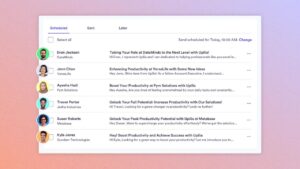What is Sales Prospecting?
Sales prospecting consists of research to find potential customers and external communication between a sales rep and the contacts they think would be a good fit for their product. Prospects are potential customers with whom sales reps are trying to sell products or solutions, which means prospecting is when you actively look for new customers to make connections with.
It’s important to understand the difference between a “lead” and a “prospect.” A “lead” is often referred to as a person or company who might be a good fit for your product. A “prospect,” on the other hand, has been identified as a good fit and is likely to become a customer.
Why is Sales Prospecting Important?
Finding new sales prospects will always be important: the more you network, the more potential customers you have in your pool. A good sales rep will constantly be researching relevant markets and looking for new opportunities.
The techniques you use while prospecting is what matters. Anyone can send out cold emails, but not everyone can make them stand out. This is what will set you apart from your competition: unique, creative sales prospecting.
If you’re new to the world of sales and want to up your game, there are numerous sales prospecting templates you can use. Find what works best and use your creativity to stand out and make a positive first impression.
Do Your Research
There’s no such thing as too much research (unless you’re on a deadline). Sales prospects will be impressed and more likely to respond if you can connect with them, so make sure you know who you’re talking to and exactly how your product will help them. This is crucial and will help ensure prospects move through the sales funnel and end.
A good sales prospecting checklist should include the following:
- Look up clients on LinkedIn, LinkedIn Sales Navigator, or other platforms and get familiar with their individual roles, as well as the larger company they’re part of.
- Research prospects to get a better idea of the work they do and uncover any needs their company may have that your product can help fulfill. Social media is a great place to start, especially if the company has public accounts you can follow.
- Reach out, and always follow up. Show your prospects you’re serious about discussing their needs, understand what they’re looking for, and can provide solutions.
Alternatively, you can lean on advancements in artificial intelligence (AI) to help your research efforts. Tools like ChatGPT can be helpful with sales discovery and research. Plus, advancements in automated sales prospecting tools, like Vidyard Prospector, will not only hunt for leads for you but also use AI to write your outbound emails as well.

 Spend less time hunting leads and more time hitting quota with Vidyard Prospector. Learn More
Spend less time hunting leads and more time hitting quota with Vidyard Prospector. Learn More Stages of Sales Prospecting
While research is crucial for sales prospecting, it doesn’t end there. A good sales rep will follow through and work towards nailing down a sale.
This is what you can typically expect to do while going through the process of sales prospecting:
- Find prospects. You’ll have to do some research (or get AI to help), rely on good old-fashioned cold calls and emails, work in some video prospecting, and lean on your network to find appropriate sales prospects.
- Grow opportunities. If, after reaching out and receiving positive responses, you find prospects that are a good match for your product, you can begin growing your relationship. The better they know and trust you, the more likely they are to purchase whatever it is you’re selling.
- Close that sale. You’ll know your sales prospecting paid off when that new customer makes a purchase.
